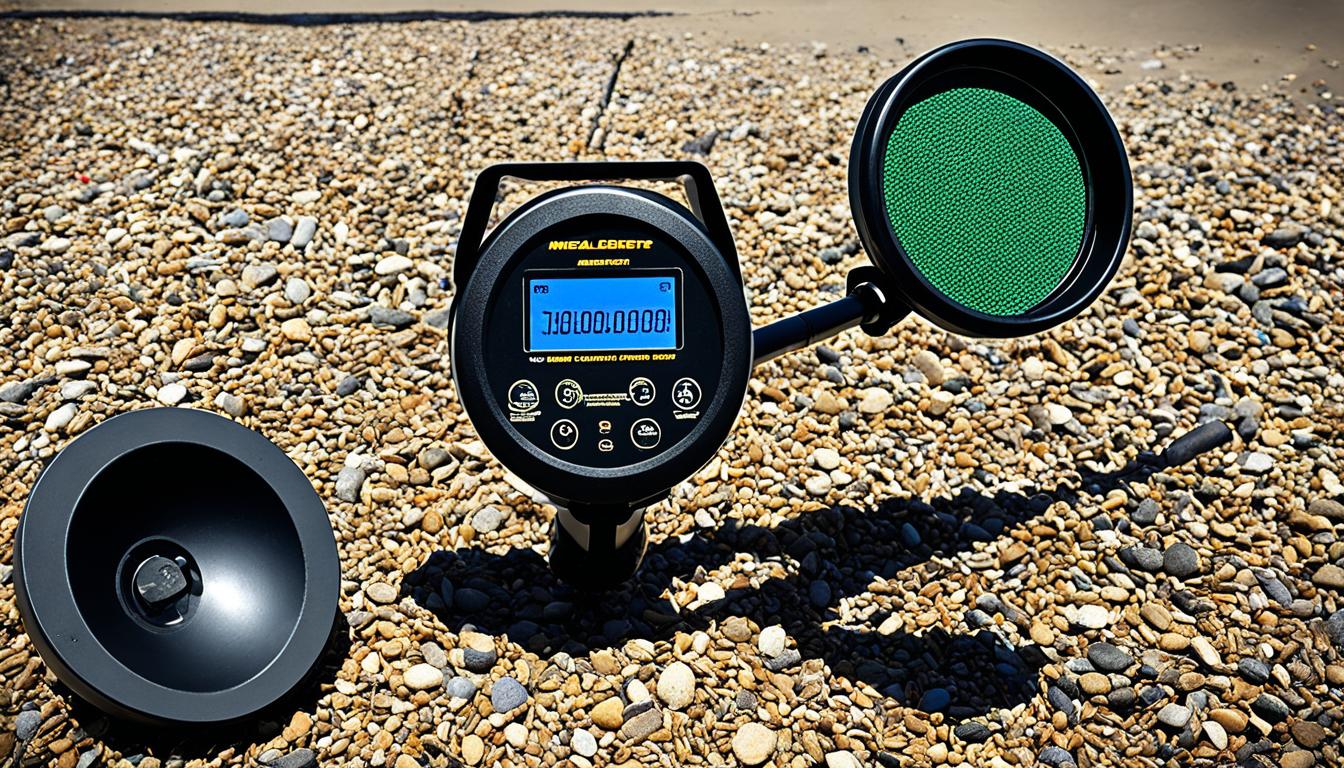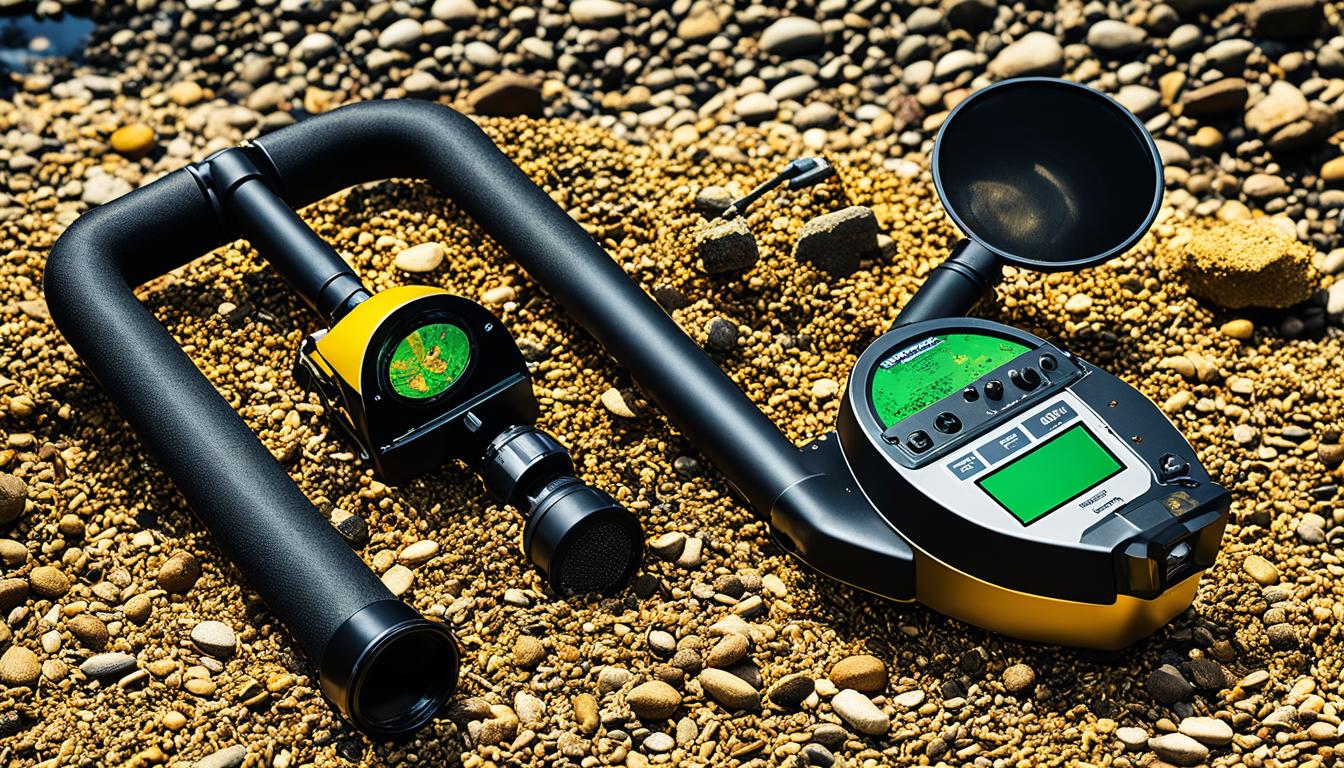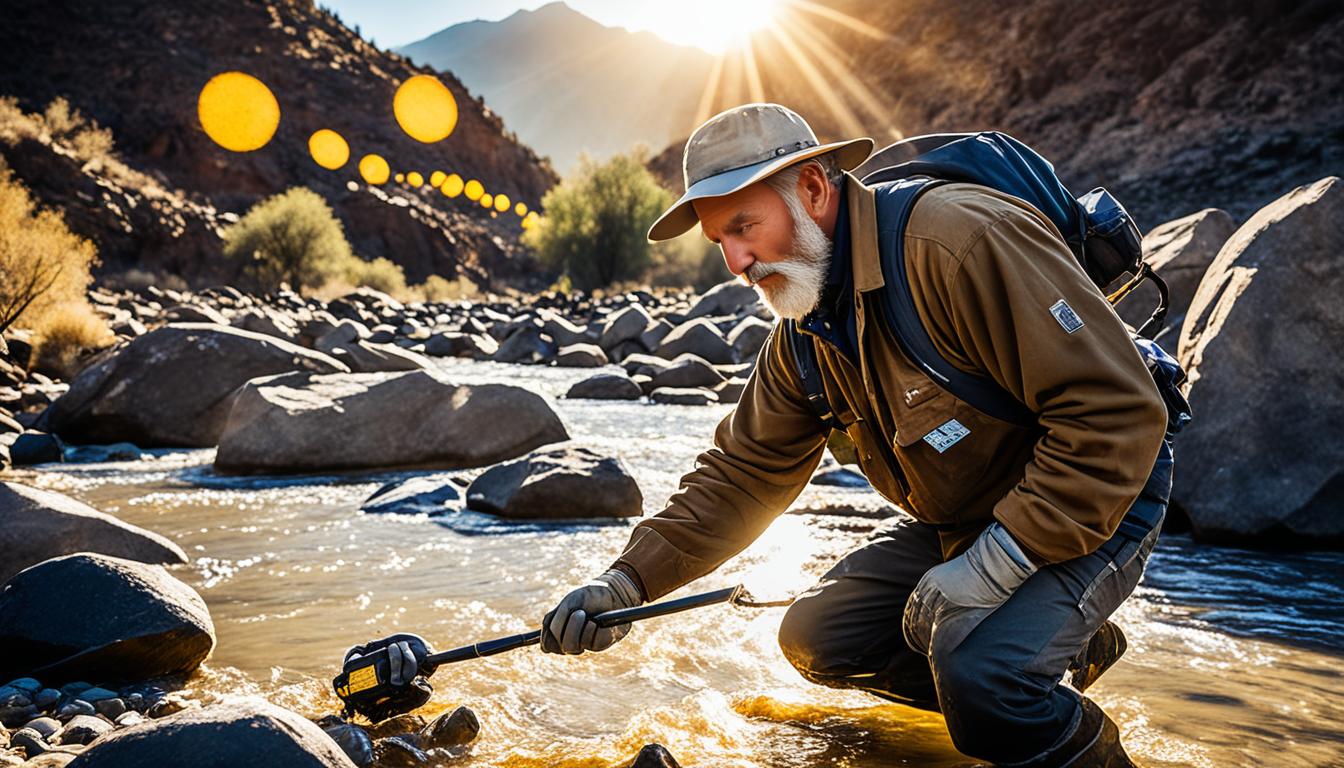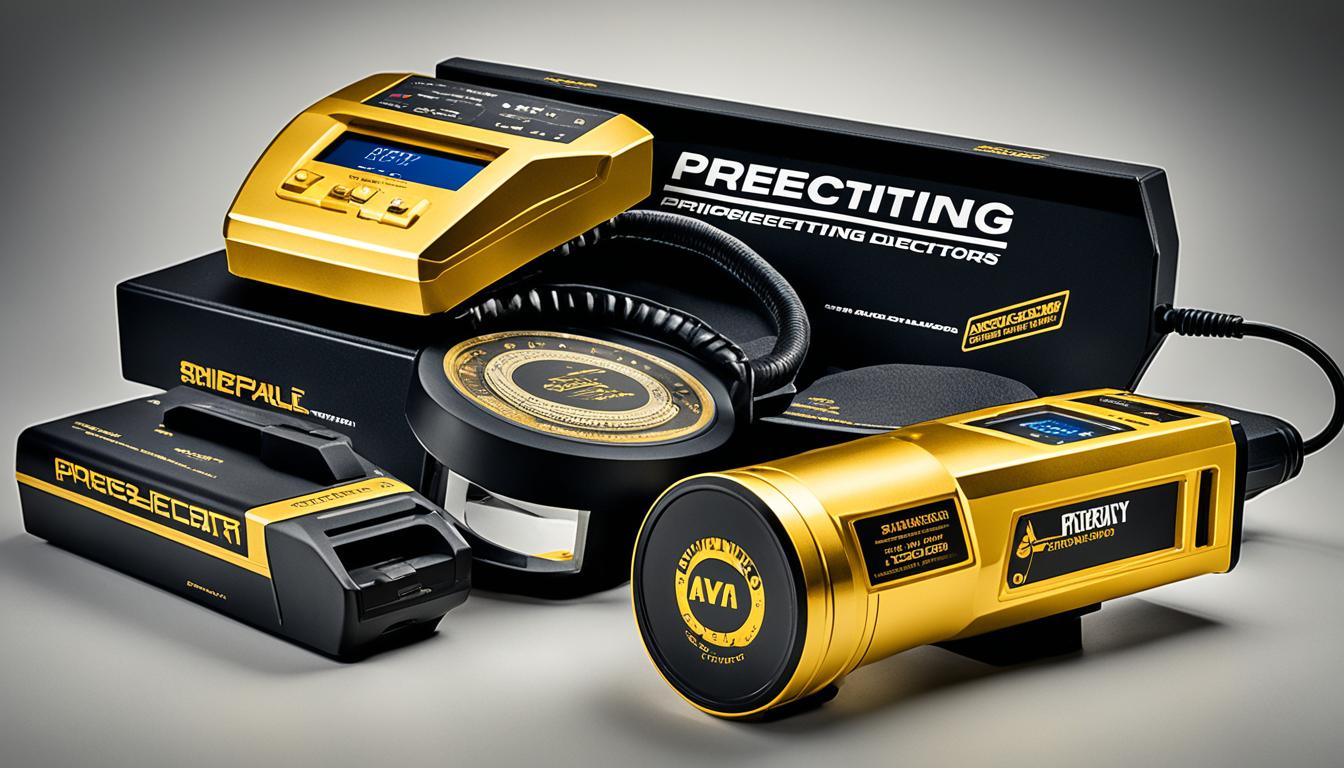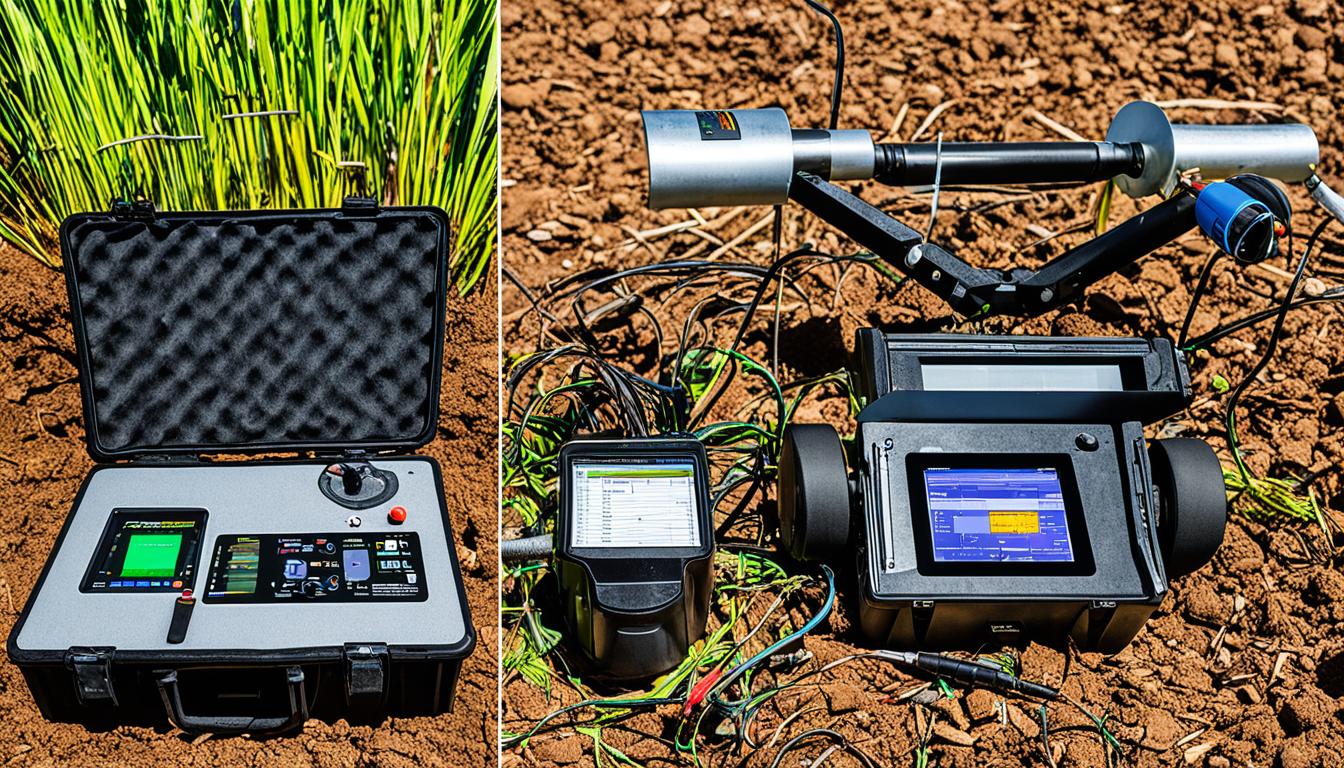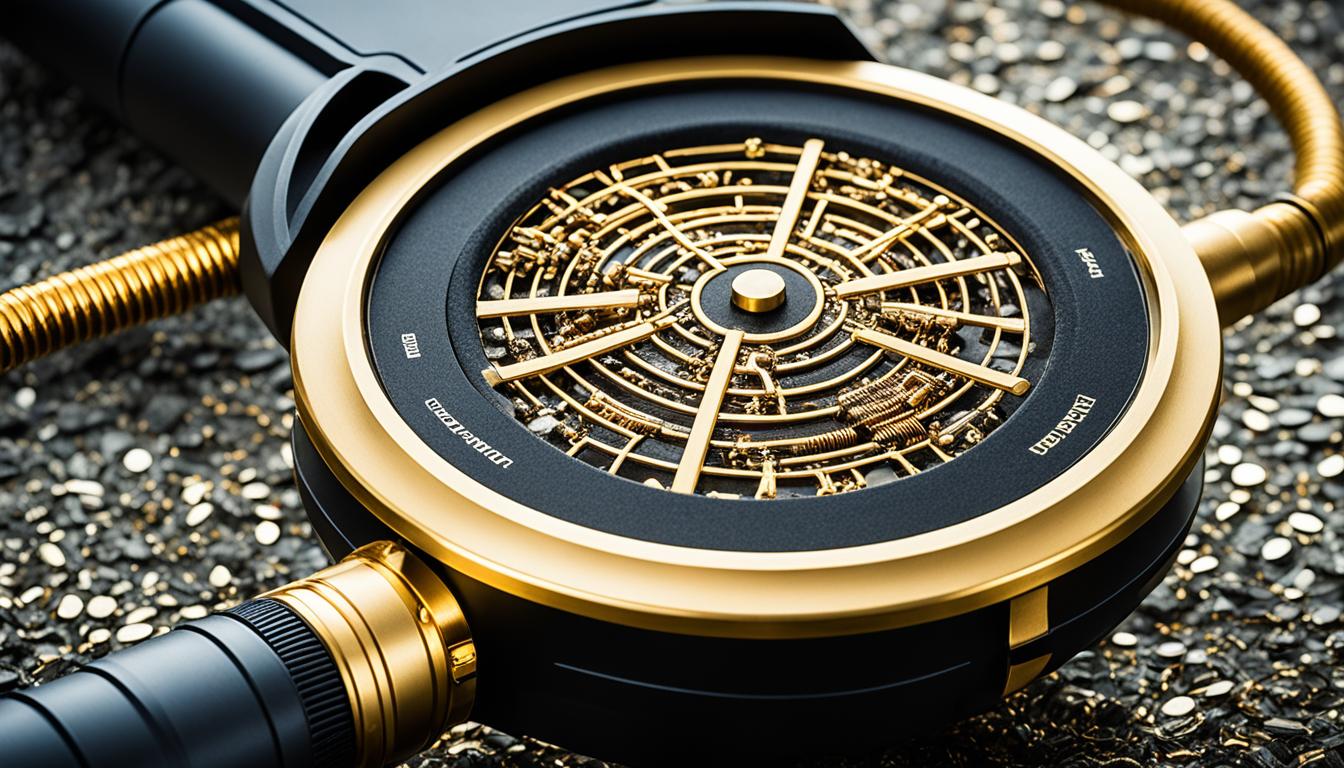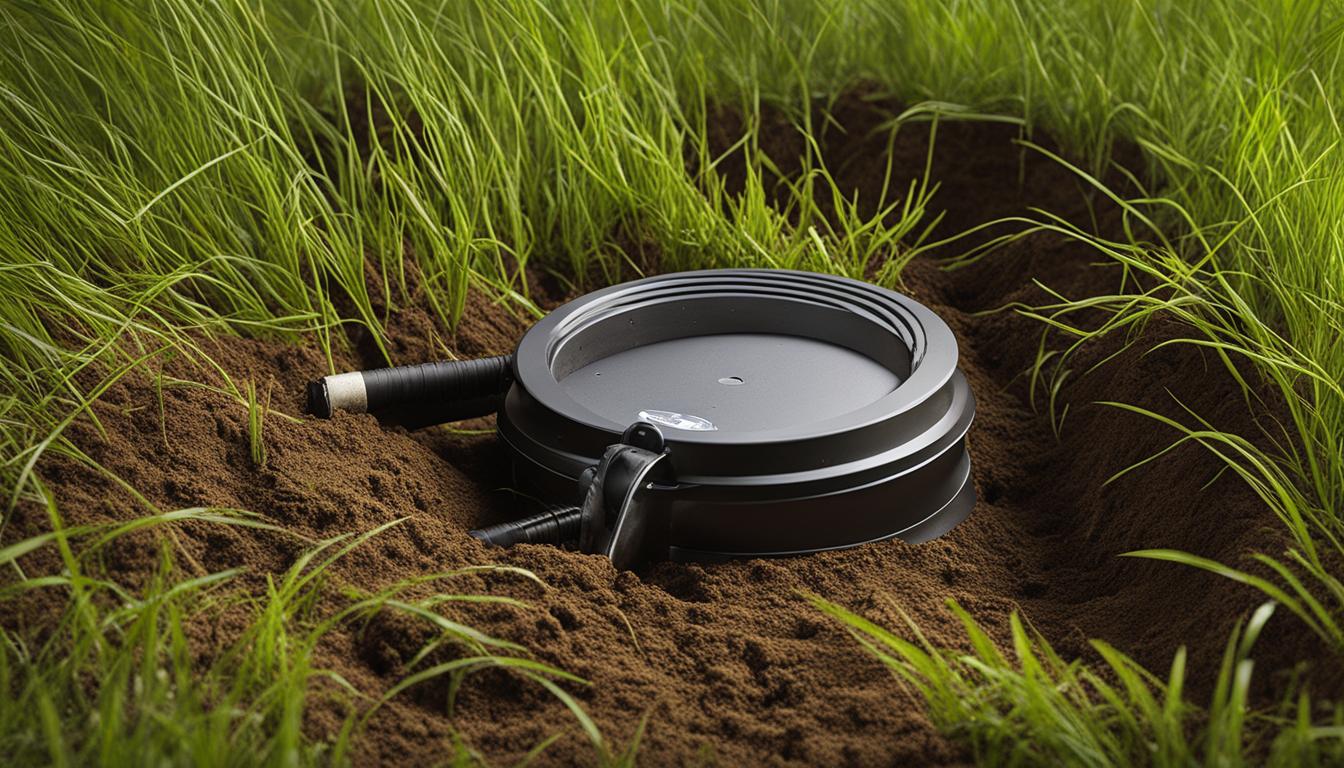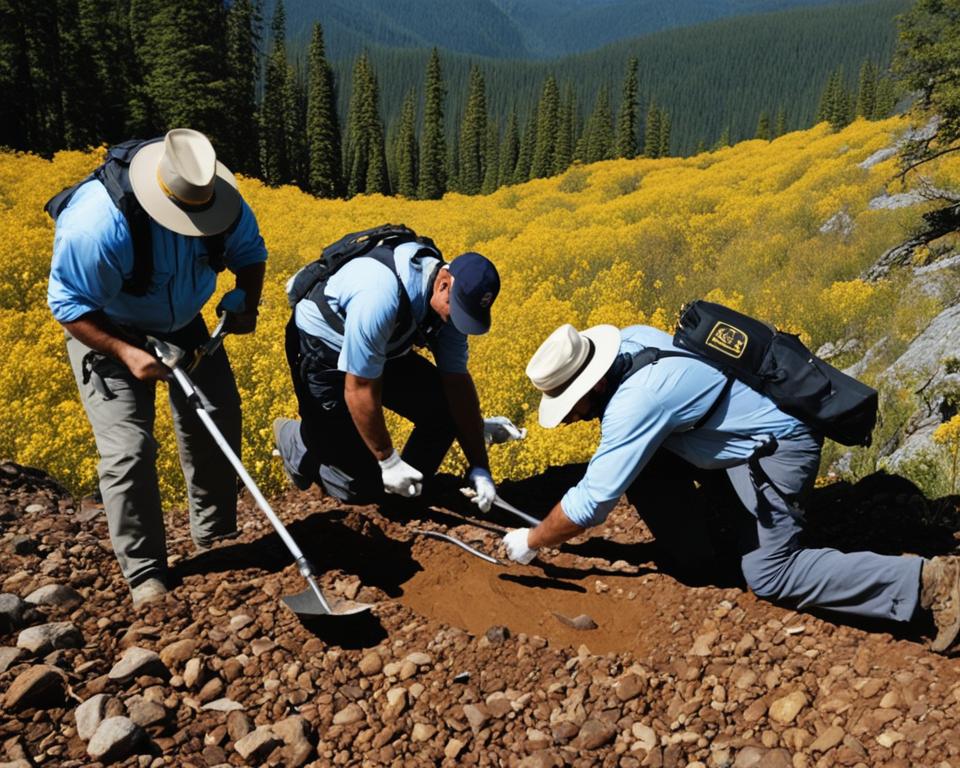
Are you ready to embark on a thrilling gold prospecting adventure? Metal detectors for gold can be your best companion in uncovering precious treasures. Whether you’re a beginner or a seasoned prospector, choosing the right metal detector is crucial for maximizing your chances of success. In this buyer’s guide, we’ll explore the different types of metal detectors, their features, and the factors to consider when purchasing one for gold prospecting.
- There are two main types of metal detectors for gold prospecting: VLF (Very Low Frequency) and PI (Pulse Induction).
- VLF metal detectors are effective in finding small gold nuggets and jewelry, while PI metal detectors excel in highly mineralized soil.
- Factors such as frequency, coil types, discrimination, and dealing with ground mineralization and hot rocks play a role in the performance of metal detectors for gold.
- Researching prospecting locations and choosing the right metal detector within your budget are essential for a successful gold detecting experience.
- Always follow local regulations and obtain necessary permits before prospecting.
VLF Metal Detectors for Gold Prospecting
When it comes to gold prospecting, VLF (Very Low Frequency) metal detectors are a popular choice among treasure hunters. These detectors utilize the principle of eddy currents to locate small gold nuggets and jewelry with precision.
The depth capabilities of VLF machines depend on various factors such as the accuracy of the settings, the type of coil used, and the ground conditions. To maximize their effectiveness, it’s essential to fine-tune the settings and choose the right coil for the specific prospecting environment.
Looking for the best VLF metal detectors for your gold prospecting adventures? Here are two top options worth considering:
- Fisher Gold Bug Pro: This metal detector is known for its exceptional sensitivity to smaller gold nuggets. With its advanced features and high-performance capabilities, the Fisher Gold Bug Pro is a reliable companion for any gold prospector.
- Gold Monster 1000: If you’re searching for tiny gold flakes, the Gold Monster 1000 is a fantastic choice. This metal detector excels at detecting and pinpointing even the tiniest traces of gold, making it an invaluable tool for serious gold prospectors.
With these top-quality VLF metal detectors in your arsenal, you’ll be well-equipped to find gold nuggets and precious jewelry with accuracy and efficiency.
| Detector | Features | Pros | Cons |
|---|---|---|---|
| Fisher Gold Bug Pro | – High sensitivity to small gold nuggets – Advanced features – User-friendly interface |
– Exceptional accuracy – Lightweight and portable |
– May struggle in highly mineralized soil |
| Gold Monster 1000 | – Detects tiny gold flakes – Versatile coil options – Easy to use |
– Excellent performance in highly mineralized soil – Lightweight and compact |
– Higher price range – May require frequent ground balance adjustments |
PI Metal Detectors for Gold Prospecting
When it comes to gold prospecting in highly mineralized soil, PI metal detectors are the top choice for avid treasure hunters. These powerful machines are designed to excel in challenging environments where hot rocks, strange salts, and extreme ground conditions prevail. With their ability to measure the speed of signal decay, PI detectors prove exceptionally effective in locating gold even in the most demanding circumstances.
Two of the most sought-after PI metal detectors for gold prospecting are the Minelab GPX 5000 and the Garrett ATX. The Minelab GPX 5000 boasts advanced features and exceptional sensitivity, allowing users to uncover gold nuggets with ease. On the other hand, the Garrett ATX is renowned for its durability and versatility, making it a trusted companion for every gold detecting expedition.
These top-notch PI metal detectors are specially designed to navigate through highly mineralized soil and offer unmatched performance in gold prospecting. Whether you’re searching for elusive nuggets or exploring new grounds, these detectors are sure to provide you with the best results and give you an edge in your gold detecting endeavors.
Why Choose PI Metal Detectors?
PI metal detectors stand out in the world of gold prospecting due to their unique capabilities and features. Here are a few reasons why choosing a PI detector for gold prospecting can greatly enhance your detecting experience:
- Superior Performance: PI detectors are specifically tailored to handle mineralized soil and detect gold targets in challenging conditions.
- Increased Sensitivity: These detectors offer high sensitivity to small gold nuggets and can penetrate deeply into the ground, providing a better chance of finding hidden treasures.
- Versatility: PI detectors are suitable for a wide range of gold prospecting conditions, including areas with hot rocks, strange salts, and extreme ground mineralization.
- Effective Discrimination: PI machines can distinguish between different types of targets, allowing you to focus on valuable gold finds while ignoring unwanted items.
With their exceptional performance and advanced features, PI metal detectors are a must-have for serious gold prospectors who are passionate about uncovering even the tiniest traces of gold.
Frequency and Coil Types for VLF Metal Detectors
VLF metal detectors operate using a range of frequencies, including both high and low. The frequency of a metal detector determines its ability to detect different targets at various depths. Higher frequencies are more effective at detecting smaller targets that are closer to the surface, while lower frequencies can reach deeper to locate larger and more conductive targets.
The performance of VLF metal detectors depends on several factors:
- Ground Conditions: The mineralization and conductivity of the soil can impact the detection capabilities of the metal detector.
- Finely-Tuned Settings: Adjusting the sensitivity, discrimination, and ground balance settings can enhance the detection of specific targets while reducing interference from unwanted signals.
- Coil Size and Type: The size and type of coil used with a VLF metal detector play a significant role in its detection capabilities.
There are three main types of coils used in VLF metal detectors:
- Mono Coils: These coils are primarily used with PI (Pulse Induction) machines and provide excellent depth and sensitivity. However, they may lack discrimination capabilities.
- Double D Coils: Double D coils can be used with both PI and VLF machines. They offer good depth and ground coverage along with improved discrimination.
- Concentric Coils: Concentric coils are specifically designed for VLF detectors. They provide accurate target identification and can work effectively in trashy areas.
| Coil Type | Pros | Cons |
|---|---|---|
| Mono Coils | Excellent depth and sensitivity | Limited discrimination capabilities |
| Double D Coils | Good depth and ground coverage | Slightly reduced sensitivity compared to mono coils |
| Concentric Coils | Accurate target identification | May struggle in highly mineralized soil |
Dealing with Hot Rocks and Ground Mineralization
Hot rocks and ground mineralization are common challenges that gold prospectors encounter when using metal detectors. These conditions can affect the accuracy of target signals and potentially lead to false detections. It is crucial for detectorists to understand how to deal with hot rocks and ground mineralization in order to improve their chances of finding genuine gold targets.
Distinguishing Hot Rocks from Targets
Hot rocks are magnetic or have magnetic properties that can cause metal detectors to indicate the presence of a target. This can be misleading and frustrating for detectorists, as hot rocks are not valuable items. However, experienced detectorists have learned to distinguish hot rocks from actual targets based on their characteristics.
“Hot rocks are like fool’s gold—shiny and alluring, but ultimately worthless.” – John Smith, experienced gold prospector
One way to identify hot rocks is by using a ferrous discrimination feature on the metal detector. This feature allows detectorists to distinguish between ferrous and non-ferrous metals. Hot rocks, being of natural mineral origin, often fall into the ferrous category. By adjusting the discrimination settings, detectorists can minimize false detections caused by hot rocks.
Understanding Ground Mineralization
Ground mineralization refers to the presence of minerals in the soil that can interfere with metal detection signals. Highly mineralized ground, often known as “hot ground,” can affect a metal detector’s ability to accurately detect targets, including gold. This is because the minerals in the ground can create additional noise and disrupt the signal pattern.
Mineralization can vary in severity, ranging from mild to extreme. Moderate or benign mineralization is more favorable for gold prospecting, as it presents fewer challenges for metal detectors. However, highly mineralized ground with hot rocks or cold stones can make detection more difficult.
Dealing with Ground Mineralization
When dealing with ground mineralization, it is important to make adjustments to the metal detector’s settings to optimize performance. This includes adjusting the sensitivity, discrimination, and ground balance settings. Experimenting with different settings and conducting frequent ground balancing can help reduce the impact of mineralization on target detection.
Additionally, using smaller coils can be beneficial when detecting in highly mineralized ground. Smaller coils are more sensitive to smaller targets and can provide better target separation in challenging conditions. Detectors with advanced ground balance features, such as automatic or tracking ground balance, are also helpful for compensating for mineralization.
The Impact of Hot Rocks and Ground Mineralization
The presence of hot rocks and ground mineralization can significantly impact gold prospecting and the accuracy of metal detectors. To better understand this impact, refer to the table below:
| Impact | Hot Rocks | Ground Mineralization |
|---|---|---|
| Effect on Metal Detector Signals | False signals and misleading indicators | Increased background noise and signal disruption |
| Detection Accuracy | Can lead to false detections or missed targets | Can make target detection more challenging |
| Difficulty Level | Moderate to high | Depends on severity: mild to extreme |
| Optimization Techniques | Adjusting ferrous discrimination, using smaller coils | Adjusting sensitivity, discrimination, and ground balance settings |
By understanding the impacts of hot rocks and ground mineralization, detectorists can apply appropriate techniques to mitigate their effects and improve their gold prospecting success.
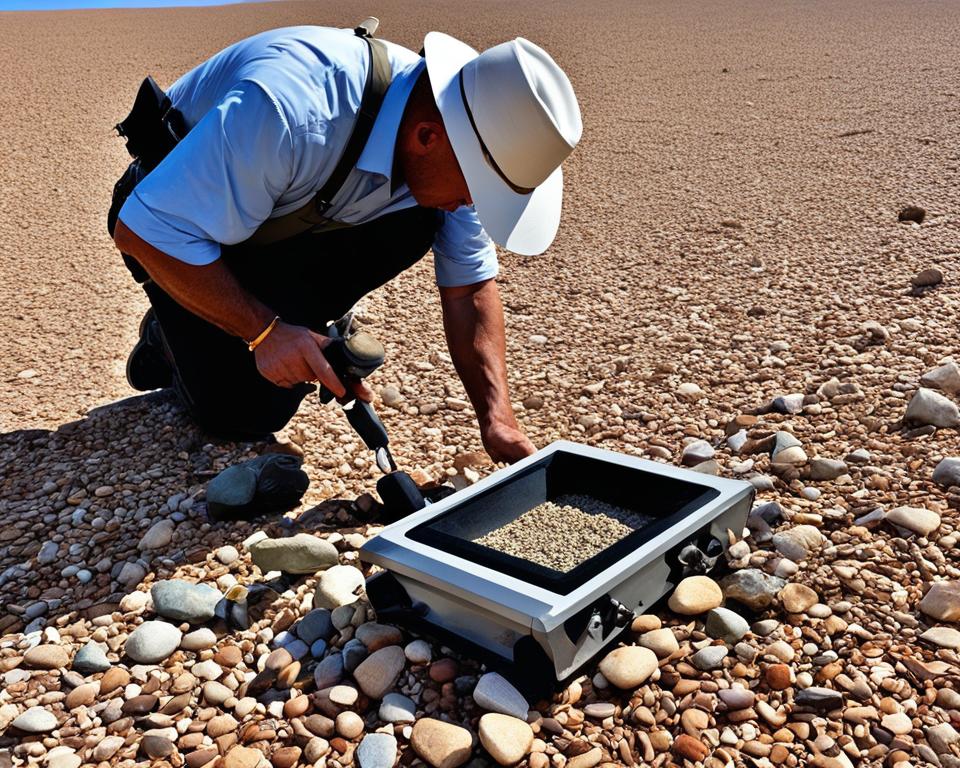
In the next section, we will explore the different coil shapes and discrimination features in gold metal detectors, which are essential considerations for successful gold prospecting.
Coil Shapes and Discrimination in Gold Metal Detectors
Metal detectors for gold prospecting come with different coil shapes, including round and elliptical. Elliptical coils are preferred for detecting in complex areas with bushes and rocks, while round coils are more versatile for general detecting.
Discrimination in gold metal detectors refers to the ability to distinguish non-ferrous targets from ferrous ones. While there is no completely accurate nonferrous discrimination for gold, some detectors offer iron discrimination to some extent. It is important to dig all targets until they are confirmed to be ferrous junk.
Prospecting for Gold in the East vs. the West
Gold prospecting locations can be found both in the East and the West of the United States. While the West is often considered the ideal region for gold prospecting due to its open and hotter terrain, the Eastern United States also boasts glacial gold areas and gold belts in states like Alabama.
Researching and exploring areas where gold has been found before is essential to maximize your chances of success. While the West may have a higher concentration of gold prospecting locations, the East can still yield promising results for dedicated prospectors. It is important to note that accessibility and staying on the gold-bearing line are the primary challenges in both regions.

Gold Prospecting Locations in the East:
- States like Alabama, Georgia, and South Carolina have historical gold-producing areas.
- The Appalachian Mountains in the Eastern United States contain gold belts.
- The glacial deposits left behind in the East can also contain gold.
Gold Prospecting Locations in the West:
- The Western United States is known for its vast open spaces and deserts, making it a popular destination for gold prospecting.
- States like California, Nevada, and Arizona have a long history of gold mining and are still popular among prospectors.
- The Alaskan wilderness offers opportunities for more adventurous prospectors.
“Whether you choose to prospect in the East or the West, thorough research, proper equipment, and persistence are key to finding gold.”
Best Metal Detectors for Gold: Top Picks
If you’re in the market for the best metal detectors for gold, you have several top options to consider. These detectors are known for their accuracy, sensitivity, durability, and versatility, making them ideal for gold prospecting. Here are the top picks:
Fisher Gold Bug Pro
The Fisher Gold Bug Pro is a highly acclaimed metal detector known for its exceptional sensitivity to small gold nuggets. With its advanced features and precise target identification, this detector is perfect for serious gold prospectors looking to uncover even the tiniest flakes of gold.
Minelab GPX 5000
The Minelab GPX 5000 is a top-of-the-line metal detector that offers advanced features and unmatched sensitivity. It’s designed to locate gold in the most challenging environments, making it a favorite among experienced prospectors. With its high performance and versatility, the GPX 5000 is a reliable choice for serious gold hunters.
Garrett ATX
The Garrett ATX is a durable and versatile metal detector suitable for all types of ground conditions. It’s known for its exceptional performance in challenging environments and its ability to detect gold with precision. Whether you’re prospecting in rugged terrains or underwater, the ATX is built to withstand the harshest conditions and deliver reliable results.
| Metal Detector | Description |
|---|---|
| Fisher Gold Bug Pro | Highly sensitive to small gold nuggets |
| Minelab GPX 5000 | Advanced features and high sensitivity |
| Garrett ATX | Durable and versatile for all terrains |
The choice of the best metal detector for gold depends on your individual preferences, budget, and specific requirements. Consider factors such as the level of sensitivity, target identification capabilities, and overall performance to determine the right detector for your needs. Each of these top picks offers exceptional features and performance, ensuring a rewarding gold prospecting experience.
Considerations for Buying a Metal Detector for Gold
When selecting a metal detector for your gold prospecting needs, there are several factors to consider that will help you make an informed choice. These factors include the frequency of use, the type of ground you will be detecting in, the number of users, and your budget.
The frequency of use is an important consideration as it will determine the durability and performance requirements of the metal detector. If you plan to use the detector frequently, investing in a sturdy and reliable model is essential.
The type of ground you will be detecting in is another crucial factor. Different grounds have varying levels of mineralization and can affect the performance of metal detectors. PI (Pulse Induction) detectors are better suited for highly mineralized soil, while VLF (Very Low Frequency) detectors work well in less mineralized soil.
If multiple users will be using the metal detector, including children, it is important to choose a detector that is user-friendly and adjustable for different heights and skill levels.
Finally, your budget plays a significant role in determining the range of metal detectors available to you. It is recommended to invest in a detector that offers a good balance of features and performance within your budget.
Along with the metal detector itself, there are accessories that should also be considered. These include trowels and scoops for digging, headphones for clear audio feedback, and coil covers to protect the search coil.
By carefully considering these factors, you can select a metal detector that meets your specific needs, offers durability, and provides an enjoyable gold prospecting experience.
Conclusion
Metal detectors for gold prospecting are invaluable tools for treasure hunters and enthusiasts. Whether you are a beginner or an experienced detectorist, choosing the right detector is crucial for a successful gold prospecting journey. Consider your personal preferences, the type of gold prospecting you plan to do, and the ground conditions you will encounter.
Both VLF (Very Low Frequency) and PI (Pulse Induction) metal detectors have their advantages and limitations. Having both types can provide you with versatility in detecting various targets and ground conditions. In your quest for gold, it is important to stay informed about the latest technology and techniques. Research prospecting locations and learn from experienced detectorists to improve your gold detecting skills.
Before heading out, always remember to follow local regulations and obtain any necessary permits for prospecting. Respecting the environment and the landowners is essential for the sustainability and enjoyment of this hobby. Happy hunting and may you uncover hidden treasures in your gold prospecting adventures!
FAQ
What are the two main types of metal detectors for gold prospecting?
The two main types are VLF (Very Low Frequency) and PI (Pulse Induction).
How do VLF metal detectors work?
VLF metal detectors use a constant sine wave to locate metallic targets.
How do PI metal detectors work?
PI metal detectors use pulses to measure the speed of the signal decay.
What are the advantages of VLF metal detectors?
VLF metal detectors are effective in finding small gold nuggets and jewelry.
What are the advantages of PI metal detectors?
PI metal detectors excel at finding targets in highly mineralized soil.
What are some popular VLF metal detectors for gold prospecting?
Some popular options include the Fisher Gold Bug Pro and the Gold Monster 1000.
What are some popular PI metal detectors for gold prospecting?
Some popular options include the Minelab GPX 5000 and the Garrett ATX.
How do VLF metal detectors differ in terms of frequency?
VLF metal detectors work with a range of high and low frequencies.
What factors affect the performance of VLF metal detectors?
Factors such as settings, coil size, and ground conditions can affect the performance of VLF metal detectors.
What are hot rocks and how do they affect metal detecting?
Hot rocks are disruptive ground conditions that can be mistaken for target signals by metal detectors.
What are some coil shapes available for metal detectors?
Coil shapes include round and elliptical.
Is discrimination possible in gold metal detectors?
While there is no completely accurate discrimination for gold, some detectors offer iron discrimination to some extent.
Where can gold prospecting locations be found?
Gold prospecting locations can be found in both the East and the West of the United States.
What are some of the best metal detectors for gold?
Some top options include the Fisher Gold Bug Pro, the Minelab GPX 5000, and the Garrett ATX.
What factors should be considered when buying a metal detector for gold?
Factors to consider include frequency of use, ground conditions, number of users, and budget.
How can one enhance their gold detecting experience?
By researching prospecting locations and staying informed about the latest technology and techniques.
Source Links
- https://modernmetaldetectors.com/blogs/news/the-ultimate-guide-to-gold-prospecting
- https://www.metaldetector.com/blogs/new_blog/how-to-select-a-metal-detector
- https://buyersguide.org/metal-detectors/t/beginners

Meet Ryan Conlon, the passionate owner and driving force behind Pan for Treasure.
With an unwavering love for the art of gold panning, Ryan has transformed his enthusiasm into a thriving community hub for fellow treasure seekers. [email protected]
A seasoned gold panning enthusiast, Ryan’s journey began with a simple pan and a dream, evolving into a deep appreciation for the history, geology, and thrill of uncovering precious metals.


